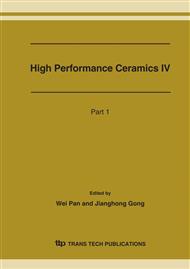p.730
p.735
p.739
p.743
p.746
p.750
p.754
p.758
p.760
Modification of Thick-Film Conductors Used in IP Technology for Reduction of Warpage during Co-Firing of LTCC (Low Temperature Co-Fired Ceramic) Modules
Abstract:
LTCC technology offers low temperature firing (<900 °C) of a materials system, which is based on LTCC sheets/tapes and (ideally) compatible thick-film components. Screen-printed materials on LTCC tapes, such as conductor, resistor, inductor thick-films are co-fired (simultaneously fired), providing a highly-functional package. This comes along with additional benefits such as ease of LTCC tape structuring, fabrication of hermetic and complex 3-D structures, etc. The major difficulty encountered arises from the differential shrinkage rate of LTCC tape and thick-film components, which has to be avoided for fabrication of warpage-free, flat surfaces that is vital for membranes, beams, etc. Therefore the goal of this study is the reduction of deformation, by matching the shrinkage rate of conductor with that of LTCC, which is achieved by mixing the commercially-available paste with selected additives.
Info:
Periodical:
Pages:
746-749
Citation:
Online since:
April 2007
Authors:
Keywords:
Price:
Сopyright:
© 2007 Trans Tech Publications Ltd. All Rights Reserved
Share:
Citation:


